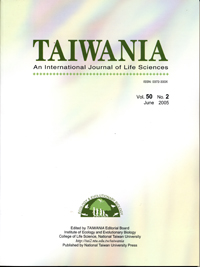Research Paper
Occurrence of Phloem in the Haustorium of Aeginetia pedunculata Wall. – A Root Holoparasite of Orobanchaceae
L. Rajanna, G. R. Shivamurthy, R. Niranjana, C. R. Vijay
Published on: June 2005
Page: 109 - 116
DOI: 10.6165/tai.2005.50(2).109
Abstract
In the present investigation, the occurrence of phloem and callose deposition on sieve plates in the haustorium of Aeginetia pedunculata Wall., a root holoparasitic herb of Orobanchaceae, is demonstrated. Our studies reveal that the haustorium of A. pedunculata has highly specialized phloem tissue, comprising of sieve tube elements and companion cells found associated occasionally with the xylem strands. More often, they are found as isolated strands in the lobes of the endophyte and the cortex of parasite root. Distinct sieve tube strands can be traced from the parasite root vasculature up to the region of the entry of the haustorium cells into the host stele. The sieve elements show the normal pattern of callose deposition. The callose deposited around the sieve pores show positive staining to lacmoid blue and fluorescence was observed, confirming their phloic nature.
中文摘要
本研究中證實了一種野菰屬根全寄生植物 (root holoparasite) Aeginetia pedunculata 的吸足 (haustorium) 確有韌皮部的存在和其篩板具胼胝質的堆積。A. pedunculata的吸足具極為特化的韌皮部組織,包含了有時與木質部相伴出現的篩管和伴細胞,這些構造更常單獨地出現在內生植物與宿主植物根部皮層相接的凹處,此明顯的篩管束由寄生植物的根部維管束可上溯至吸足的細胞進入宿主植物之中柱區域。篩管的胼胝質位篩板的周圍,呈現一般的正常堆積形式,對lacmoid blue 染劑呈螢光反應,可確定其屬韌皮部。
Keyword: Aeginetia pedunculata, phloem, callose, fluorescence, haustorium, Orobanchaceae.


